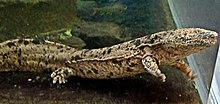隱鰓鯢科
| 隱鰓鯢科 化石時期:侏羅紀中期至今
| |
|---|---|

| |
| 日本大鯢 | |
| 科學分類 | |
| 界: | 動物界 Animalia |
| 門: | 脊索動物門 Chordata |
| 綱: | 兩棲綱 Amphibia |
| 目: | 有尾目 Urodela |
| 亞目: | 隱鰓鯢亞目 Cryptobranchoidea |
| 科: | 隱鰓鯢科 Cryptobranchidae Fitzinger, 1826 |
| 屬 | |
| |
隱鰓鯢科(學名:Cryptobranchidae),為隱鰓鯢亞目下之一科。終生生活在水中,成體保有鰓裂,體側有皮膚褶皺以增加皮膚面積用於在水中呼吸,前肢4趾後肢5趾。
行為[編輯]
日本大鯢的人工飼養壽命長達 52 年[1]。
進食[編輯]
中國大鯢以水生昆蟲、魚、蛙、蟹和蝦為食 [2][3]。 由於視力不佳,它們利用頭部和身體上的感覺節點探測水壓的微小變化,從而找到獵物[4]。
繁殖[編輯]
在交配季節,蠑螈會向上游移動,雌性會在那裡產下兩串卵,每串 200 多枚[5]。 雄性蠑螈沒有其他物種那種刻板的求偶行為,它會在卵上釋放精子,使卵在外面受精,然後守護卵至少三個月,直到卵孵化[6]。 在這一階段,幼蟲以明顯儲存的脂肪為食,直到它們準備好捕食。一旦準備就緒,它們就會成群捕食,而不是單個捕食。
分類[編輯]
泛隱鰓鯢類 Pancryptobrancha
- †烏克蘭鯢屬 Ukrainurus
- †Ukrainurus hypsognathus
- †初螈屬 Chunerpeton
- †天義初螈 Chunerpeton tianyiensis
- 隱鰓鯢科 Cryptobranchidae
- 隱鰓鯢屬 Cryptobranchus
- 大鯢屬 Andrias
- 中國大鯢 Andrias davidianus (可能為至少五個不同物種的複合種)
- 華南大鯢 Andrias sligoi [8][9]
- 日本大鯢 Andrias japonicus
- †Andrias bohemicus
- †Andrias matthewi
- †薛氏鯢 Andrias scheuchzeri
- 屬 †Aviturus
- †Aviturus exsecratus
- 屬 †Ulanurus
- †Ulanurus fractus
- 屬 †Zaissanurus
- †Zaissanurus beliajevae'
參考文獻[編輯]
- ^ Andrias japonicus. amphibiaweb.org. [2023-09-04]. (原始內容存檔於2023-07-27).
- ^ Encyclopedia of Reptiles & Amphibians. books.google.com. [2023-09-04]. (原始內容存檔於2023-08-30).
- ^ What eats the giant Chinese salamander?. www.idsemergencymanagement.com. [2023-09-04]. (原始內容存檔於2023-08-30).
- ^ Chinese Giant Salamander. www.earthsendangered.com. [2023-09-04]. (原始內容存檔於2023-08-30).
- ^ Исполинская саламандра – живое бревно. yavitrina.ru. [2023-09-04]. (原始內容存檔於2023-08-30).
- ^ What special adaptations do Giant Salamanders possess?. petreader.net. [2023-09-04]. (原始內容存檔於2023-09-04).
- ^ 引用錯誤:沒有為名為
fw110598的參考文獻提供內容 - ^ World's largest amphibian identified as a unique species. Animals. 2019-09-16 [2019-09-17]. (原始內容存檔於2021-02-04) (英語).
- ^ Turvey, S. T.; Marr, M. M.; Barnes, I.; Brace, S.; Tapley, B.; Murphy, R. W.; Zhao, E.; Cunningham, A. A. Historical museum collections clarify the evolutionary history of cryptic species radiation in the world's largest amphibians. Ecology and Evolution. 2019, 00 (18): 10070–10084. doi:10.1002/ece3.5257
 .
.
外部連結[編輯]
| 維基物種上的相關資訊:隱鰓鯢科 |
- BBC article with video on Giant salamanders from Japan (頁面存檔備份,存於網際網路檔案館)
- Cryptobranchid Interest Group
- Tree of Life: Cryptobranchidae (頁面存檔備份,存於網際網路檔案館)
- Chinese Giant Salamander
- Japanese Giant Salamander (頁面存檔備份,存於網際網路檔案館)
| |||||||||||||||||||||||||
|

